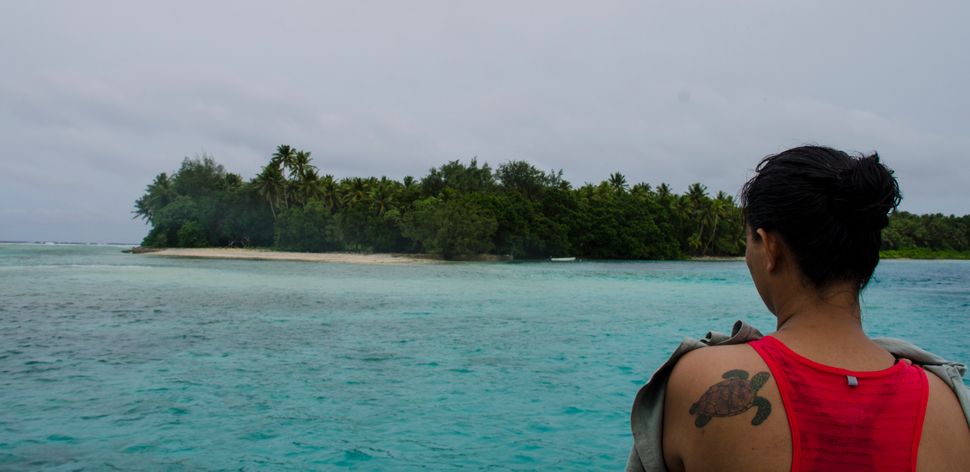Peter Mellgard is a deputy editor of Noema Magazine and the editor of the Berggruen Press.
BIKIRAN ISLAND, Marshall Islands — Candice Guavis stepped out of the turquoise lagoon onto the beach of this remote and pristine island, home only to a caretaker who tends to the forest and the coastline.
“We’ve started calling him Wilson,” Guavis said, smiling. “Like in ‘Cast Away.’ Once when we came he was listening to the radio and dancing by himself.” She strode inland under the shade of coconut palms. Gesturing at a plastic bottle dangling from a string tied to a branch, she said, “He’s been leaving scraps of Bible verses in these bottles all over the island. It must get lonely out here sometimes.”
This tiny island sits on Majuro Atoll, halfway between Hawaii and Australia. But it faces an uncertain future. As the world enters the age of climate change, Bikiran is on the front lines. Sea level rise and other effects of climate change threaten the Marshall Islands more than almost any other country on Earth.
Guavis works for the Marshall Islands Marine Resources Authority, and Bikiran is one of the protected areas MIMRA staff and caretakers watch over. They’ve built rudimentary seawalls — piles of coconut palms and other organic debris — to stop the wind and waves and the rising sea from crumbling the island back into the ocean.
“It’s the traditional method,” Guavis said. “Our elders say it’s the most effective way. We plant pandanus trees on top — they can withstand the salt and their roots hold everything together.”
Preparing for climate change in the Marshall Islands involves a lot of this kind of traditional knowledge melded with modern science. These islands were colonized thousands of years ago, and over time the Marshallese have achieved a deep understanding of their precarious and sensitive environment — the crashing waves of the Pacific, the ceaseless wind, the scarce freshwater, the fish and the breadfruit tree. Modern climate science now injects a sense of urgency.
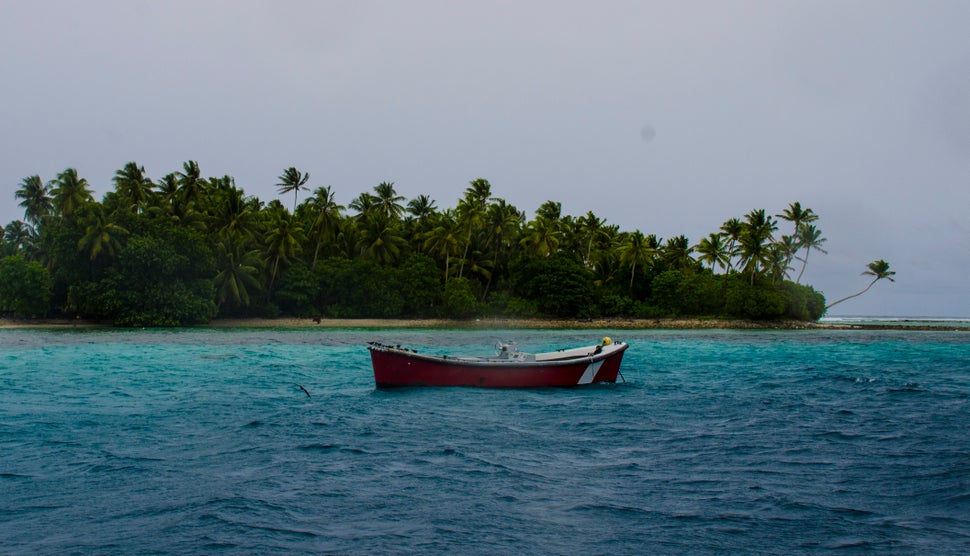 Peter Mellgard / The WorldPost
Peter Mellgard / The WorldPostThere are 29 low-lying atolls and five islands in the Marshalls. They are surrounded by an ocean that extends for thousands of leagues in every direction, idyllic strips of white sand and palm trees that rise gently out of blue emptiness. Just offshore are some of the finest coral reefs in the world. The population is slightly more than 70,000, contained mostly on the largest island and capital, Majuro.
At the Paris climate negotiations, President Christopher Loeak and Minister Tony de Brum both spoke with passion and urgency, calling on world governments to agree to limit global warming to 1.5 degrees Celsius, saying it was the only level of warming that could keep Marshalls a viable place to live.
“Everything I know and everything I love is in the hands of all of us gathered here in Paris,” Loeak said on Nov. 30.
The 1.5-degree target still hangs in the balance, with de Brum and other officials from developing states squaring off against much of the developed world, which is leaning toward an official target of 2 degrees.
Everything I love is in the hands of all of us gathered here in Paris.
Even before the age of climate change, the atolls that make up the Marshall Islands were a dangerous place to build a nation. Curt Storlazzi of the U.S. Geological Survey explained their particular sensitivity. The base of an atoll island is an ancient volcano millions of years old. Once upon a time, these in the Marshalls rose high out of the ocean, something like the limestone pillars you can see in parts of China or Thailand. Due to the Pacific plate’s subsidence, they slowly sank below sea level, and coral colonized their slopes. “Coral is like humans,” Storlazzi said. “It is born, it lives and it dies. Once corals die they leave behind a carbonate structure. That carbonate structure creates sediment” — the waves bash the coral and create sand and gravel — “and that sediment gets washed up and forms these atoll islands and islets.”
Majuro’s highest point is just 10 feet above the water. Most of the other islands never rise above six feet. The islands are constantly shifting — growing in some places, shrinking in others. But beyond the natural hazards, climate change is expected to present a variety of new challenges here — more intense drought, the decay of coral reefs, bigger storms. It has become evident that sea level rise is the most dangerous and will make all the other effects worse.
“People are really on a knife edge here,” said Dan Dieckhaus, a regional adviser at the U.S. Agency for International Development in Majuro, which runs education, preparation and disaster relief programs throughout the distant atolls in the Marshall Islands. “It’s safe to say that climate change is going to make things tougher. The point of our work is to give them a fighting chance.”
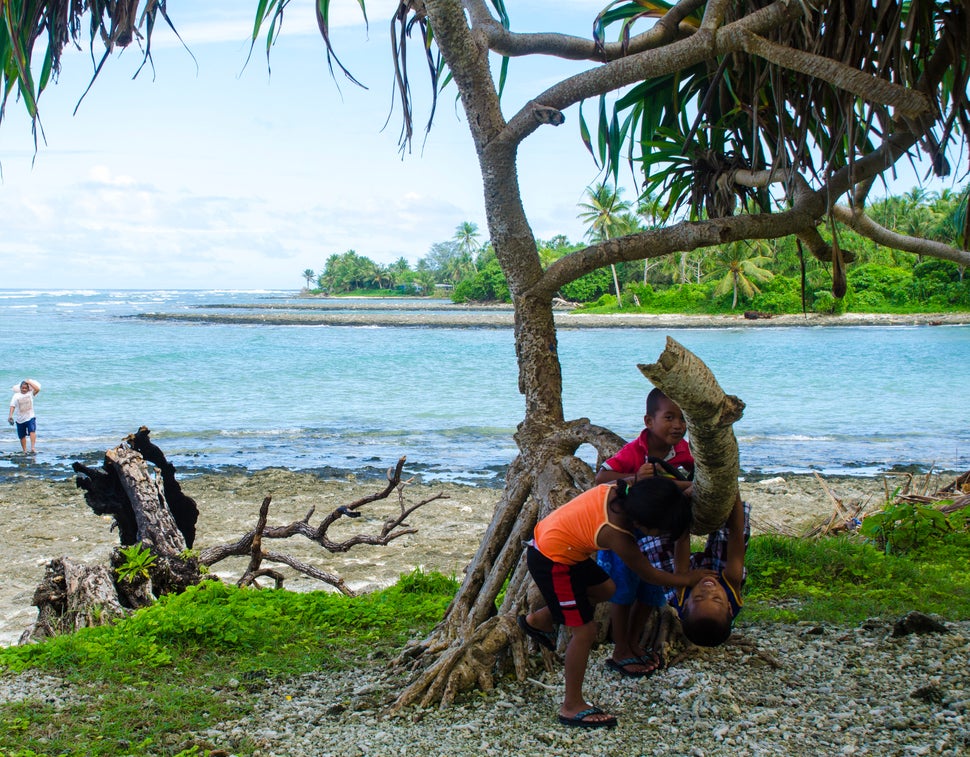 Peter Mellgard / The WorldPost
Peter Mellgard / The WorldPostThe ocean has risen here faster than almost any place on the planet, an average of 7 millimeters per year since 1993, the year the Australian government started taking measurements. The vertical accretion rate of the coral reefs is low, Storlazzi said, about 1 to 4 millimeters per year. Islands that were once 6 feet tall are now close to 5 feet tall. Islands 5 feet tall today could be 4 feet tall in a few years. A storm that brings high waves will cause seawater to wash up onto the island. Because the islands are lower, smaller and more common storms will cause the same destructive flooding as the bigger storms do now.
During a bad flood, seawater washes over the islands, erodes unprotected land, floods people’s homes, destroys crops and contaminates groundwater reserves. It can take more than a year to recover. Scientists expect some of the islands in the Marshalls will be inundated by around 2100. But long before then, overwash events are going to happen more frequently, maybe annually, making it impossible for the mostly poor, densely populated and underprepared island communities to recover.
“Unlike places like the Florida Keys,” Storlazzi said, “you can’t move to Jacksonville. These are island nations that have a culture thousands of years old that are really going to be the first climate-change refugees under the U.S. defense umbrella.”
But not all of the Marshall Islands’ environmental problems are due to climate change. Many, perhaps most, are manmade. Poor urban planning is immediately evident in Majuro and some of the other islands; Ebeye, hundreds of miles to the northwest, has long been called the slum of the Pacific. Pollution is unchecked. Garbage is dumped on coral reefs. Raw sewage is poured directly into the ocean just off Majuro. Materials like sand and gravel for coastline fortification are collected from sensitive locations with ineffective oversight.
On a coral plateau just off the southeastern edge of Majuro Atoll’s biggest island, Karl Fellenius scuffed his flip-flop into the algae that carpeted the ground.
Hypnea seaweed, blue green algae and funnel weed had colonized the area. It was evidence of how reckless development can impact a pristine environment. “This stuff blocks the coral off from the sunlight and contributes to even more algae,” Fellenius said. He works for the University of Hawaii and is studying coastal management and resources in the Marshall Islands. “If coral settles on algae-covered coral rock,” he said, “it doesn’t attach. Look around — you don’t see many bare patches.”
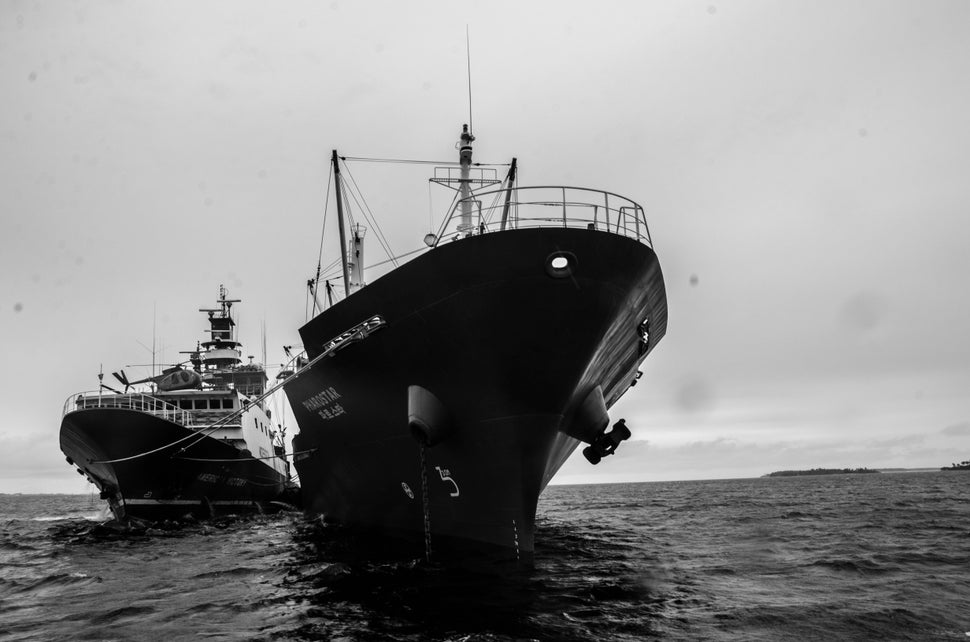 Peter Mellgard / The WorldPost
Peter Mellgard / The WorldPostCoral reefs are more than a tourist attraction for atolls like those in the Marshall Islands — they form their very foundation. If they deteriorate, the durability of the islands and the conditions for people living on them erodes. Human development has already put the coral reefs at a disadvantage — poorly built seawalls, which fortify almost the entire capital, can end up causing long-term damage to the islands’ foundation, and pollution and sewage have promoted an explosion of coral-killing algae. With the ocean warming and acidifying because of climate change, the outlook is worrying.
Fellenius pointed to the edge of the reef where the side of the atoll plummets into the ocean depths. Majuro’s only sewer pipe was just three feet below the breaking waves, pumping raw sewage into the ocean. The reef all around was dead.
An old cast iron pipe used to pump the sewage at a safer depth of around 70 feet. It’s been broken for at least 10 years, according to the Majuro Water and Sewer Company, which expects it to be another few years before repairs can start.
Polluting the sea like this has caused health problems and structural damage to the foundation of the islands. A healthy ocean means a healthy reef. And healthy reefs mean land to live on, food to eat and protection against storms. As Guavis put it: “Everything is connected.”
“If you don’t have a healthy reef, you’re not producing the stuff that makes the islands,” Fellenius said. “Of course, you can elevate and fortify everything, but then you’re not really living in a tropical paradise anymore, are you?”
The effects of climate change are multiplying the manmade damage to the Marshall Islands’ coral reefs. The country endured its worst-ever coral bleaching event between September and December of 2014. Fellenius recorded the destruction that climate change wrought on the reefs, noting “the corals died within days of getting bleached.” Bleached corals don’t often revive. While reporting this story, The WorldPost witnessed ongoing coral bleaching off the coast of Kalalen Island in the middle of Majuro Atoll’s northern rim.
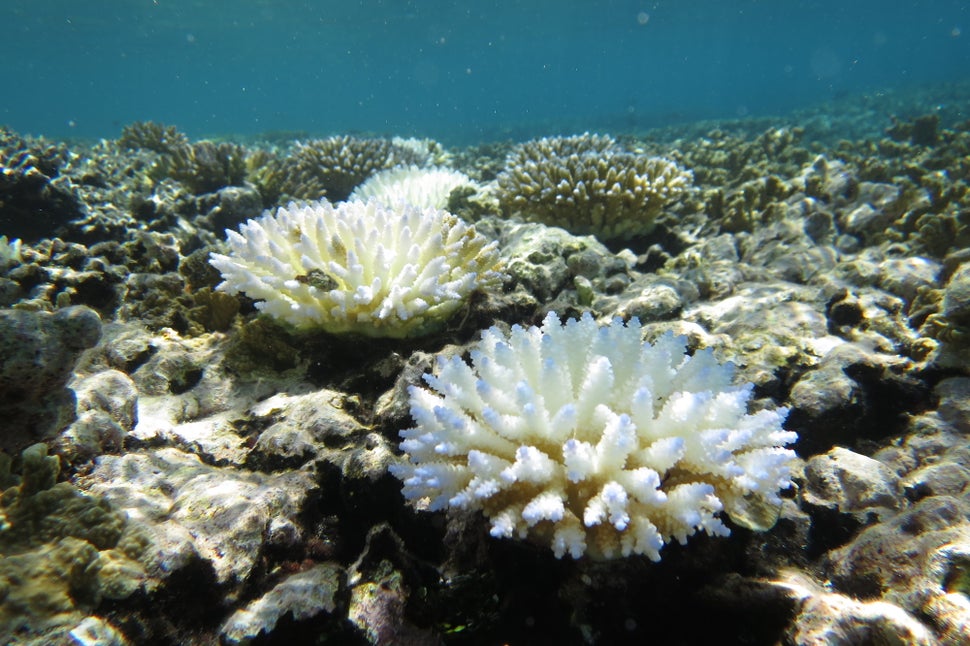 Hiroaki Ueda / Raycrew Diveshop, Majuro
Hiroaki Ueda / Raycrew Diveshop, MajuroNo matter what the cause, a deteriorating environment is a massive problem for such a precarious place as the Marshall Islands. The long-term health of coral reefs and coastlines is vital. But you can’t plan for the future without information about the past and the present.
Mark Stege runs a project at the College of the Marshall Islands called Noah’s Ark. It’s a lot of things: a digital mapping initiative, so researchers can understand how the islands are shifting, how sea level has changed, where trees grow and where people live. It’s also a cultural time capsule, a way to capture life on the islands and preserve it forever, come what may.
“What we’re doing is gathering all that data in order to better understand impacts and develop some appropriate response measures,” Stege said. “And in the process you’re digitizing the Marshalls. You’re creating a digital record, a virtual world. You’re archiving. You’re building your Noah’s Ark.”
Stege and others are operating under the assumption that climate change is going to continue to threaten the Marshall Islands. A few people are following the Paris negotiation, but not many. Hope that diplomats will come to some agreement that will solve problems over here is muted.
“Climate change sucks,” Stege observed dryly, standing in the oppressively humid courtyard of the College of the Marshall Islands. Students ambled sluggishly through the morning sun and the wind gusted unceasingly through the trees. Stege’s eyes looked sad, and his beard was flecked with early grays. In a sterilized and air-conditioned office upstairs, he gestured at a stack of ordinary servers, the current container of gigabytes of Marshallese history, culture, environmental data and island maps — the Noah’s Ark.
“This is it,” he said. “Not very exciting. The islands, we’re told, are going to go back into the ocean, lost forever. But there’s still much more life here, quite a bit more history that needs to be written. Through this work, at least we’ll have a record of it. It’s not for nothing.”
CORRECTION: A previous version of this story misidentified Curt Storlazzi as Carl Storlazzi.

